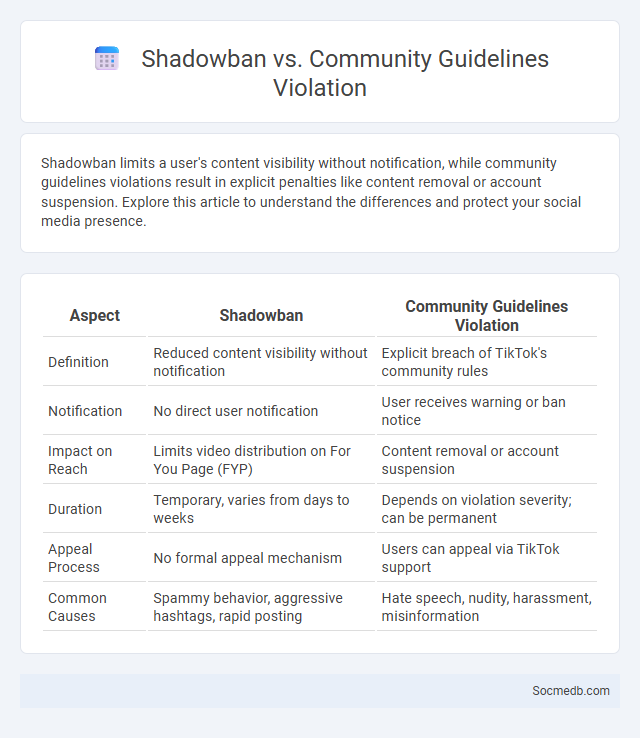
Photo illustration: Shadowban vs Community Guidelines Violation
Shadowban limits a user's content visibility without notification, while community guidelines violations result in explicit penalties like content removal or account suspension. Explore this article to understand the differences and protect your social media presence.
Table of Comparison
| Aspect | Shadowban | Community Guidelines Violation |
|---|---|---|
| Definition | Reduced content visibility without notification | Explicit breach of TikTok's community rules |
| Notification | No direct user notification | User receives warning or ban notice |
| Impact on Reach | Limits video distribution on For You Page (FYP) | Content removal or account suspension |
| Duration | Temporary, varies from days to weeks | Depends on violation severity; can be permanent |
| Appeal Process | No formal appeal mechanism | Users can appeal via TikTok support |
| Common Causes | Spammy behavior, aggressive hashtags, rapid posting | Hate speech, nudity, harassment, misinformation |
Understanding Shadowban: Definition and Impact
Shadowban refers to a covert restriction imposed by social media platforms that limits the visibility of a user's content without notification, effectively reducing engagement and reach. This hidden penalty impacts user interaction metrics, such as likes, comments, and follower growth, often causing confusion and frustration among affected accounts. Understanding the algorithmic triggers and content policies leading to shadowbans is crucial for maintaining organic reach and ensuring compliance with platform guidelines.
What Are Community Guidelines Violations?
Community guidelines violations refer to actions or content that breach the rules set by social media platforms to maintain a safe and respectful environment. These violations often include hate speech, harassment, misinformation, graphic violence, and spam, which undermine user experience and platform integrity. Understanding these rules helps you avoid penalties like content removal, account suspension, or permanent bans.
Shadowbanning vs Shadowban: Clearing the Confusion
Shadowbanning refers to the covert restriction of a user's content visibility on social media platforms, effectively limiting engagement without explicit notification. The terms "shadowban" and "shadowbanning" are often used interchangeably but specifically, shadowban denotes the act or instance of being subjected to this limitation. Understanding the nuances between these can help users recognize changes in their content reach and address potential violations of platform policies more effectively.
Key Differences Between Shadowban and Violations
Shadowban restricts the visibility of a user's content without notification, often due to algorithmic detection of suspicious activity, whereas violations refer to explicit breaches of platform policies that typically trigger formal warnings or account penalties. Shadowbans are subtle and can lower engagement by hiding posts from non-followers, while violations are overt infringements such as hate speech, misinformation, or spam, leading to content removal or account suspension. Understanding this distinction helps in effectively managing social media presence and complying with platform guidelines.
How Shadowban Affects User Reach and Engagement
Shadowban on social media significantly reduces a user's visibility by limiting their content's appearance in feeds, searches, and hashtag results, leading to sharply decreased reach. Reduced reach directly impacts engagement metrics such as likes, comments, and shares, as fewer users interact with the suppressed posts. This decline in engagement can harm overall account growth and brand presence, as algorithms interpret lower interaction rates as decreased content quality.
Reasons Behind Community Guidelines Violations
Community guidelines violations often stem from users posting harmful or inappropriate content such as hate speech, misinformation, or explicit material that disrupts the platform's safe environment. Your posts might inadvertently breach rules due to misunderstandings of platform policies or accidental sharing of copyrighted material. Frequent violations can result in account suspensions, content removal, and reduced visibility, emphasizing the importance of adhering to social media standards.
Signs You Might Be Shadowbanned
Decreased engagement rates, such as significantly fewer likes, comments, or shares on Your posts, often indicate a shadowban on social media platforms. A sudden drop in reach or lack of visibility in hashtag searches can also be a strong sign that your content is being restricted. Monitoring changes in follower interaction and testing posts on different accounts can help confirm a potential shadowban.
Dealing with Shadowbanning: Recovery Steps
Shadowbanning on social media can significantly reduce your content's visibility, impacting engagement and growth. To recover, first audit your posts for any violations of platform guidelines and promptly remove or edit problematic content. You should also increase genuine interaction by engaging with followers through comments, likes, and shares while diversifying your content types to restore algorithmic favor and boost reach organically.
Preventing Community Guidelines Violations
Ensuring your social media content aligns with platform policies reduces the risk of community guidelines violations, which can lead to account suspension or content removal. Regularly reviewing the specific rules of platforms like Facebook, Instagram, and Twitter helps you stay compliant by avoiding prohibited content such as hate speech, misinformation, or graphic violence. Utilizing automated monitoring tools and fostering transparent communication within your online community supports proactive prevention and maintains your account's credibility.
Navigating Platform Policies: Best Practices for Compliance
Navigating platform policies requires a thorough understanding of each social media network's specific guidelines on content, user conduct, and advertising standards to ensure compliance and avoid penalties. Your best practices include regularly reviewing updates, using compliance tools designed for monitoring policy changes, and training your team on standardized enforcement procedures. Implementing proactive measures helps maintain your brand's reputation and secures uninterrupted access to social media marketing opportunities.
 socmedb.com
socmedb.com